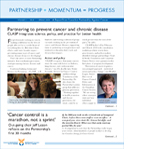Partnering to prevent cancer and chronic disease
CLASP integrates science, policy and practice for better health
April 23, 2009

For professionals working in cancer, making a difference in the lives of people affected by it is at the heart of everything they do. But what if their efforts could have broader impact preventing many types of cancer and chronic diseases from ever developing?
That’s the intent of a new Partnership initiative that coordinates prevention strategies among chronic diseases and cancer. Coalitions Linking Action & Science for Prevention (CLASP) will fund new and existing coalitions of groups currently working in the prevention of cancer and chronic diseases, supporting them in partnering across provinces and territories to broaden their reach and deepen their impact.
Action and policy

“CLASP recognizes that many cancers share the same risk factors as diabetes, lung diseases, and cardiovascular diseases,” says Dr. Jon Kerner, Senior Scientific Advisor for Cancer Control and Knowledge Translation at the Partnership. He also chairs the Partnership’s action group that addresses primary prevention. “Working together in health promotion and disease prevention, the whole could be so much greater than the sum of the parts,” he adds.

CLASP kicked off in February and March 2009 with consultation workshops where researchers, practitioners, and policy-makers identified strategic partnerships. The Heart & Stroke Foundation and the Canadian Cancer Society were partners in this first phase of program development. “Prevention of cancer requires a two-pronged approach – individual action and policy change,” says Heather Logan, Senior Director of Cancer Control Policy and Information at the Canadian Cancer Society. “We are seeing where synergies exist and how individual efforts might be strengthened through partnership.”
Why CLASP?
Chronic diseases, such as heart disease, stroke, cancer, chronic respiratory diseases, and diabetes, are by far the leading cause of mortality in the world, representing 60 per cent of all deaths.
Out of the 35 million people who died from chronic disease in 2005, half were under 70. – World Health Organization
Planning meetings are taking place across the country throughout the spring to invite teams interested in CLASP to help inform the development of a request for proposals as well as review funding criteria.Following peer review of eligible proposals, the Partnership anticipates funding between five and 10 CLASP initiatives beginning October 2009, with continued support to March 2012. Funded coalitions and CLASP partners will participate in semi-annual knowledge exchange meetings to share lessons learned and evaluate the work completed to date.
This “bottom-up” consultation and knowledge exchange process will shape a new Partnership investment in cancer and chronic disease prevention that is dictated by the needs from the field, building on the important work already happening across Canada.
 The article above is also available in the Partnership’s Spring 2009 newsletter. If you, or your organization, would like printed copies of the newsletter please contact us.
The article above is also available in the Partnership’s Spring 2009 newsletter. If you, or your organization, would like printed copies of the newsletter please contact us.
To receive e-bulletins about Partnership activities, please subscribe.
